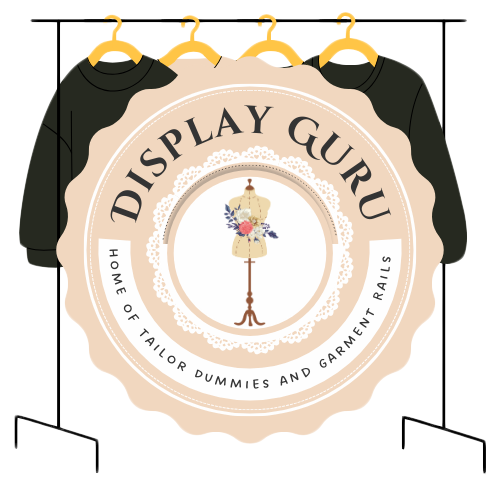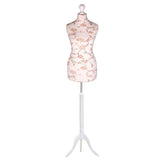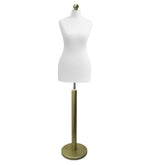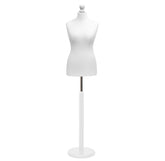7 Creative Sewing Room Storage Ideas for 2025
A well-organised sewing room is more than just aesthetically pleasing; it is the engine of creativity and efficiency. When every spool, fabric remnant, and pair of scissors has a dedicated home, you spend less time searching and more time bringing your visions to life. Yet, achieving this level of organisation can feel like a significant task, especially when dealing with an ever-growing collection of materials and limited space.
This guide cuts through the clutter, offering a curated collection of practical and innovative sewing room storage ideas designed to streamline your workflow and maximise your workspace. We'll explore solutions that go beyond basic bins, from leveraging vertical space with versatile pegboards to implementing mobile systems that adapt to your projects. Prepare to transform your sewing space from a zone of creative chaos into a sanctuary of organised calm. Inside, you will discover actionable strategies to implement immediately, ensuring your tools and materials are always ready for your next masterpiece.
1. Pegboard Wall Organization System
A pegboard wall is one of the most versatile and effective sewing room storage ideas for transforming cluttered worktops into organised, functional zones. This system utilises perforated hardboard panels mounted to a wall, allowing you to create a completely customised storage display with an array of hooks, baskets, shelves, and containers. It excels at maximising vertical space, a critical advantage in smaller sewing rooms or studios where floor space is at a premium.
The primary benefit of a pegboard is that it keeps your most-used tools visible and within immediate reach. Say goodbye to rummaging through drawers for your favourite fabric shears or rotary cutter; with a pegboard, everything has a designated, accessible home. This visual approach not only saves time but also reduces friction in your creative process, allowing for a smoother workflow whether you're quilting, dressmaking, or pattern cutting.
Why It Works for Sewing Spaces
Pegboard systems are highly adaptable to the unique demands of a sewing room. Large cutting mats and rulers can be hung securely, while small containers attached to hooks can hold easily lost items like bobbins, buttons, and machine needles. Brands like IKEA have popularised this concept with their SKÅDIS system, but traditional workshop-style pegboards offer a robust alternative, often with a wider variety of heavy-duty hook options. The ability to reconfigure the layout as your projects or tool collection changes ensures it remains a long-term solution.
Actionable Implementation Tips
To get the most out of your pegboard, consider these practical strategies:
- Group by Function: Arrange tools in logical groups. Keep all your cutting implements together, place marking tools like chalk and pens in another section, and dedicate an area for threads and bobbins.
- Secure Your Accessories: Use peg locks or a small dab of hot glue to keep hooks from lifting off the board when you remove a tool.
- Integrate Colour: Paint the pegboard to match your room’s décor. A neutral colour can help reduce visual clutter, making your colourful threads and tools stand out as features.
- Create a Visual Hierarchy: The principles of good visual merchandising can be applied to your own workspace. By organising your tools with intent, you create an environment that is both efficient and aesthetically pleasing. For more on this, you can explore detailed visual merchandising guidelines that apply equally well to a professional studio or a home craft room.
2. Rolling Cart Storage Systems
A rolling cart is an incredibly flexible and practical component of any well-organised sewing room, offering mobile storage that adapts to your workflow. These multi-tiered units provide a compact, movable station for your essential supplies, allowing you to bring your tools directly to your cutting table, sewing machine, or ironing board. As one of the most dynamic sewing room storage ideas, a rolling cart is perfect for multi-purpose spaces where you need to clear away your sewing station after use.
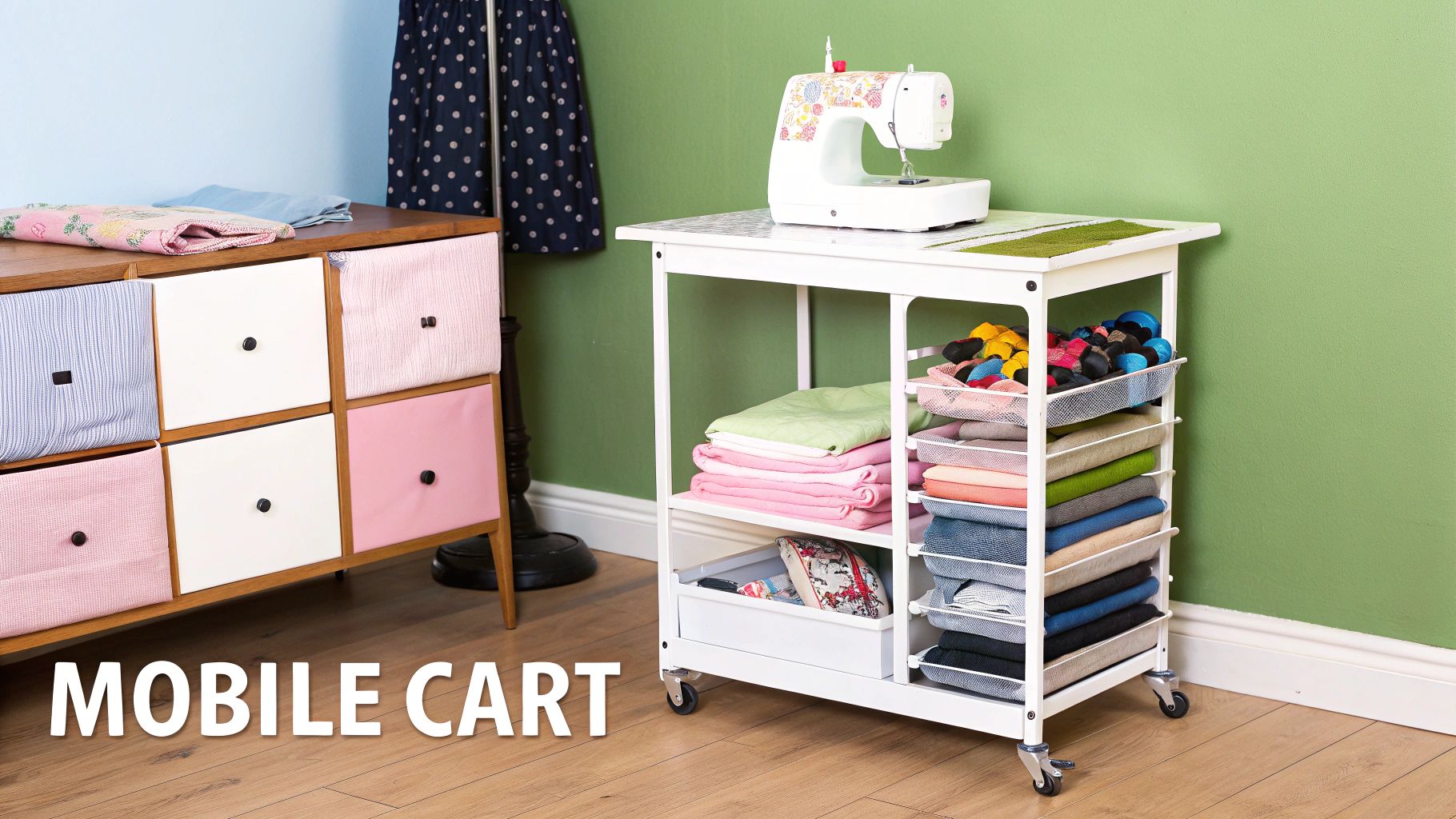
The key advantage of a rolling cart is its mobility. Instead of you moving back and forth to a shelf or drawer, the supplies come to you. This streamlines the creative process, saving precious time and energy during complex projects. Carts like the IKEA RÅSKOG have become a staple in craft rooms, but many other models, such as those from Honey-Can-Do, offer various configurations with shelves, shallow trays, and deep baskets to hold everything from fabric fat quarters to cones of overlocker thread.
Why It Works for Sewing Spaces
Rolling carts are perfectly suited for the fluid nature of sewing. You can dedicate a cart to a specific project, loading it with the necessary fabric, thread, and notions, and then roll it away when you switch tasks. Their small footprint makes them ideal for fitting into tight corners or under desks, a significant benefit for anyone working with limited room. The open-shelf design keeps supplies visible and accessible, preventing you from buying duplicates of items you already own but have forgotten about. This mobility is a core principle of efficient design in compact areas; you can explore a deeper dive into utilising such furniture in our guide to small sewing space ideas.
Actionable Implementation Tips
To maximise the efficiency of your rolling cart, apply these organisational strategies:
- Zone Your Supplies: Dedicate each tier to a specific function. Use the top for frequently used tools like scissors and seam rippers, the middle for current project fabrics, and the bottom for heavier items or less-used notions.
- Use Internal Dividers: Add small containers, jars, or custom-fit drawer dividers within the cart’s trays to corral small items like bobbins, buttons, and machine feet. This prevents them from becoming a jumbled mess.
- Label Everything: Attach simple labels to your containers or the front of each tray. This makes finding what you need at a glance effortless and maintains order.
- Lock the Wheels: When you have your cart positioned where you need it, engage the wheel locks (if available). This provides stability and prevents it from rolling away while you work.
3. Thread Storage Towers and Racks
Tangled threads and mismatched bobbins can bring a creative project to a standstill. Specialised sewing room storage ideas like thread towers and racks tackle this problem head-on by providing a dedicated, organised system for your entire spool collection. These units, which range from wall-mounted racks to rotating desktop towers and even drawer inserts, are designed to keep every colour visible, accessible, and free from knots.
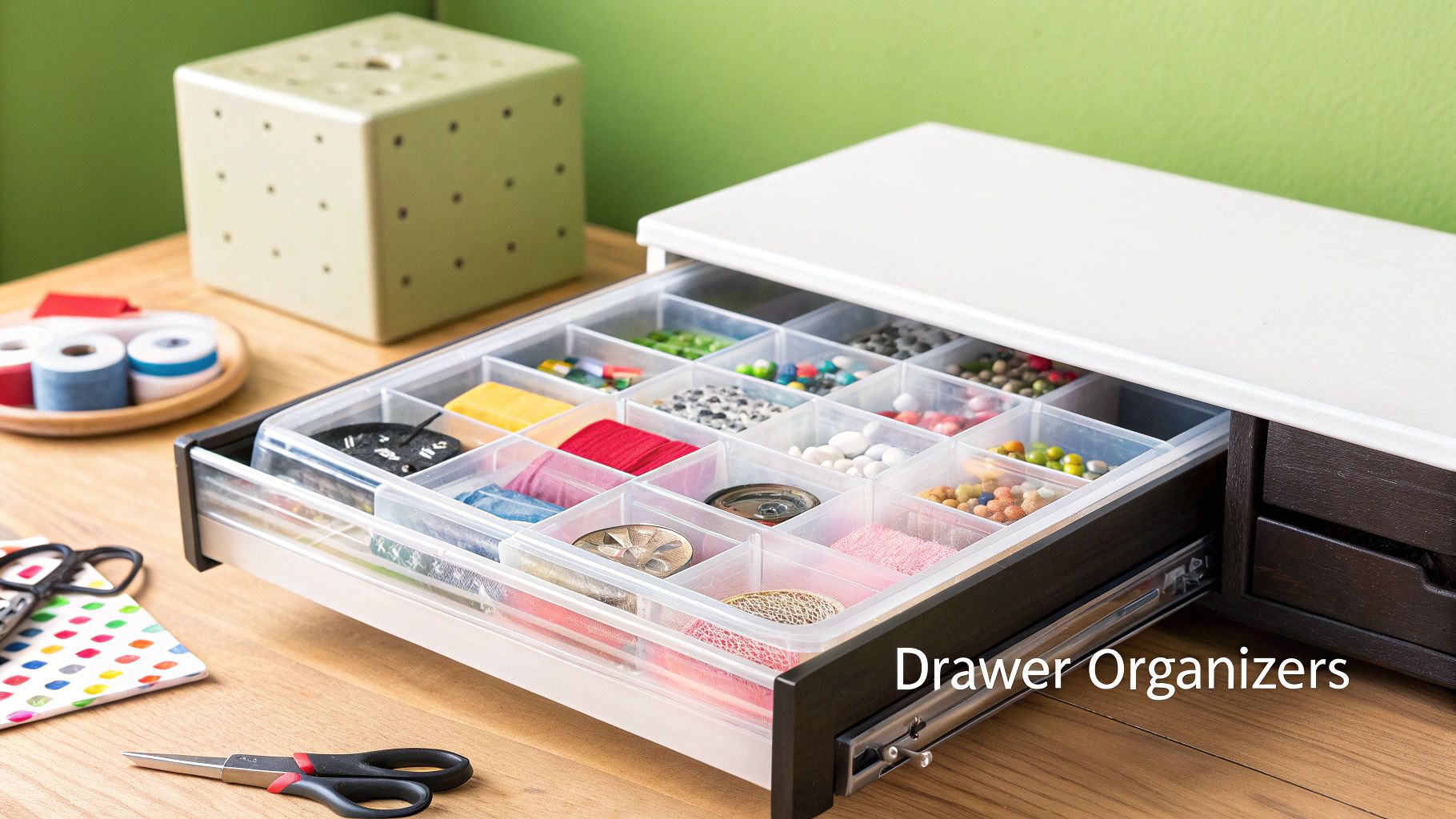
The core advantage of a dedicated thread rack is efficiency. It allows you to quickly find the exact shade you need without digging through a chaotic bin, saving valuable time and preventing frustration. Furthermore, proper storage protects the integrity of your thread by shielding it from dust and UV light, which can degrade fibres and cause fading over time. This makes it an essential tool for professional quilters, embroiderers, and anyone who values precision in their work.
Why It Works for Sewing Spaces
Thread storage systems are purpose-built for the unique needs of a sewist. Unlike generic containers, they feature spindles or pegs that perfectly accommodate standard spool sizes from brands like Sulky, Gutermann, and Coats. Wall-mounted racks are excellent for utilising vertical space and transforming your thread collection into a vibrant visual feature. Rotating towers offer high-capacity storage in a compact footprint, ideal for placing beside your sewing machine for quick changes during complex projects.
Actionable Implementation Tips
To maximise the effectiveness of your thread storage, follow these practical strategies:
- Organise by Colour: Arrange your spools in a logical colour spectrum, like a rainbow. This visual organisation makes it incredibly easy to find the perfect hue at a glance.
- Consider Accessibility: Place your most frequently used threads-like black, white, and neutrals-in the most accessible positions on your rack or tower.
- Protect from Sunlight: Position your thread storage away from windows or direct sunlight to prevent the colours from fading and the thread from becoming brittle.
- Match System to Spools: Before purchasing, ensure the rack's spindle size and spacing can accommodate the specific brands and spool types you use most, whether they are small spools, large cones, or embroidery threads.
4. Clear Drawer Organizer Systems
One of the most satisfying yet effective sewing room storage ideas involves taming the chaos inside your drawers with clear organiser systems. These modular plastic or acrylic compartments fit neatly inside drawers, creating dedicated spaces for small but essential sewing notions. By preventing items like bobbins, buttons, needles, and snaps from getting lost or jumbled, they transform a cluttered "junk drawer" into a highly efficient, categorised hub of supplies.
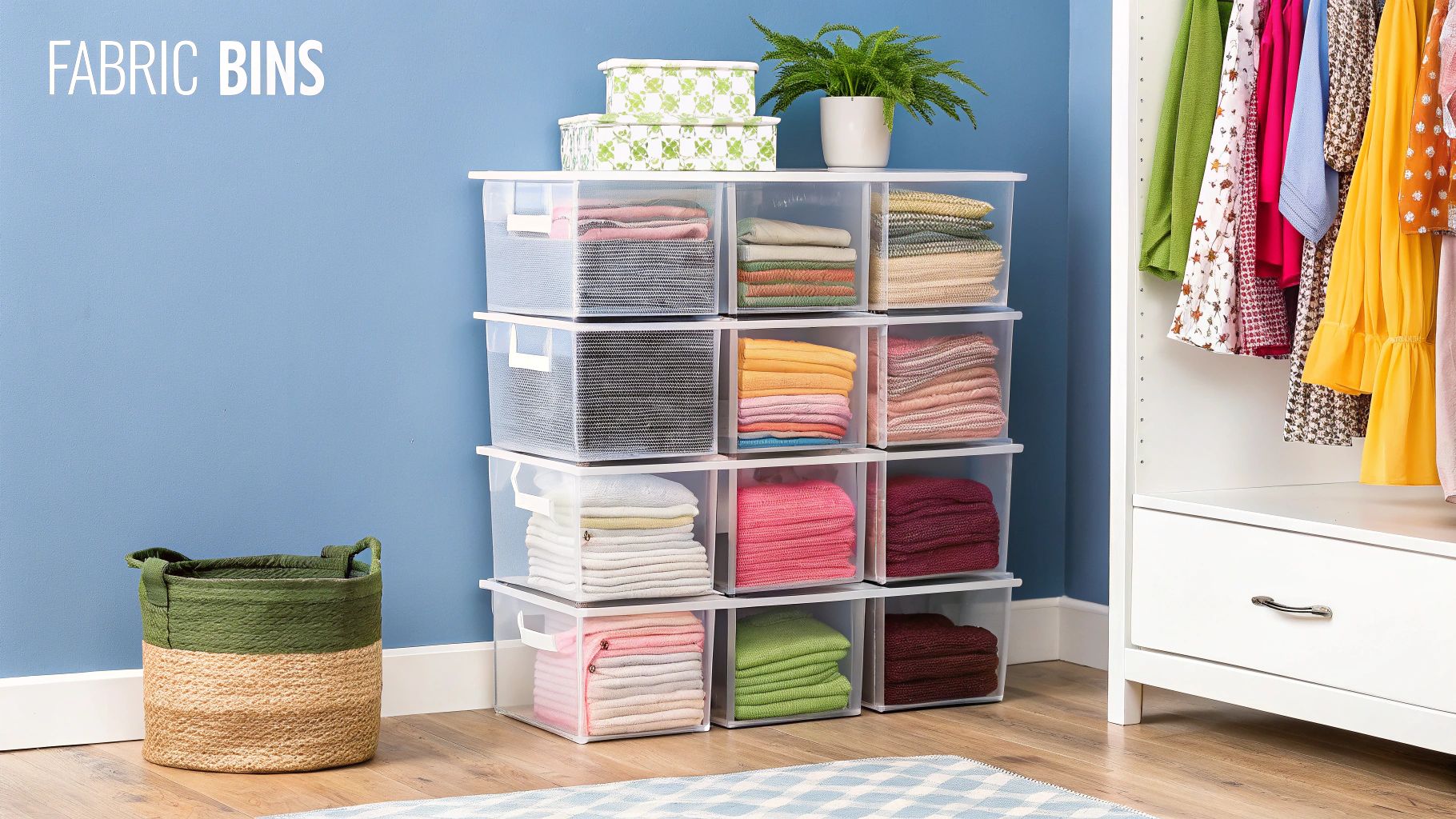
The key advantage of transparent organisers is immediate content identification. You can see exactly what you have and where it is at a glance, eliminating guesswork and speeding up your workflow. This approach aligns perfectly with organisational philosophies popularised by experts like Marie Kondo, where every item has a visible and accessible home. For a professional tailor or a home sewist, this means less time searching and more time creating.
Why It Works for Sewing Spaces
Sewing rooms are notorious for accumulating a vast number of small, easily misplaced items. Clear drawer organisers are the perfect solution. They come in a wide variety of interlocking sizes, allowing you to create a completely bespoke layout tailored to your specific drawer dimensions and inventory. For example, IKEA's GODMORGON box sets, though designed for bathrooms, are perfectly suited for sewing notions, while The Container Store offers extensive collections specifically for craft rooms. This modularity ensures every square centimetre of drawer space is used effectively.
Actionable Implementation Tips
To maximise the effectiveness of your drawer organisers, implement these strategies:
- Measure Before You Buy: Carefully measure the internal length, width, and depth of your drawers to ensure the organisers will fit perfectly without sliding around.
- Group by Category: Dedicate specific compartments to similar items. Keep all your machine feet in one section, various types of zips in another, and assorted buttons sorted by colour or size.
- Use Stackable Options: For deeper drawers, choose stackable organiser trays. Place less frequently used items in the bottom layer and everyday essentials on top for easy access.
- Subdivide for Tiny Items: Use smaller containers or dividers within a larger compartment to manage minuscule items like machine needles, beads, or sequins, preventing them from mixing.
5. Fabric Storage Cubes and Bins
Managing a growing fabric collection is a universal challenge for sewists, and using dedicated sewing room storage ideas like fabric cubes and bins is a game-changer for maintaining order. This method involves using uniform containers, such as stackable plastic boxes, open-front cubes, or even repurposed comic book boards, to categorise and protect your fabric stash. It moves fabric off shelves and out of bags, creating a tidy, searchable library of your materials.
The core advantage of this system is its ability to protect fabric from dust, light, and pests while making it easy to see what you own. Transparent bins, like IKEA's popular SAMLA range, allow you to identify colours and prints at a glance, preventing you from buying duplicates. For more delicate or vintage textiles, acid-free archival boxes offer superior protection, ensuring your most prized fabrics remain in pristine condition for years to come.
Why It Works for Sewing Spaces
Fabric storage bins bring uniformity and efficiency to what can easily become a chaotic collection. By folding fabric to a consistent size, often around a comic book board or a custom-cut piece of card, each piece becomes a neat 'mini-bolt'. This allows you to stack them vertically or horizontally within a bin, maximising space and preventing deep creases. This structured approach is especially beneficial for quilters managing vast collections of fat quarters or for dressmakers organising cuts of fabric by project.
This system is also highly scalable. As your stash grows, you can simply add more matching bins, maintaining a cohesive and organised look. Whether you opt for stackable boxes tucked away in a cupboard or stylish fabric cubes displayed in a KALLAX-style shelving unit, the system adapts to your space and inventory.
Actionable Implementation Tips
To effectively implement this storage solution, consider the following strategies:
- Standardise Your Folding: Use comic book boards or uniform-sized card to wrap your fabric. This creates consistent parcels that fit neatly into your chosen containers and are easy to file through.
- Categorise Logically: Organise your bins by fabric type (cottons, jerseys, silks), colour family, or specific project. Label each bin clearly on the outside for quick identification.
- Consider Weight and Accessibility: Place bins containing heavier fabrics like denim or upholstery materials on lower shelves or in rolling carts to avoid heavy lifting. Keep your most-used fabrics in the most accessible containers.
- Optimise for Your Collection: For smaller cuts like fat quarters, smaller, more compact boxes work best. For larger, multi-metre cuts of dressmaking fabric, deeper bins are more suitable. You can explore more comprehensive sewing room ideas to find the perfect container-to-fabric ratio for your needs.
6. Over-the-Door Organisers
An over-the-door organiser is one of the most ingenious sewing room storage ideas for reclaiming unused space and decluttering your work area. These systems hang conveniently on the back of a door, transforming a blank surface into a multi-pocketed storage hub. Perfect for rooms where wall and floor space are at a premium, they provide an immediate solution for organising a wide range of sewing notions, tools, and supplies that might otherwise get lost in drawers or clutter your desk.
The key advantage of this method is its ability to offer high-density storage without occupying any primary real estate in your sewing room. By utilising vertical space that is often overlooked, you can store everything from scissors and seam rippers to patterns and small fabric scraps. This out-of-the-way approach helps maintain a tidy, focused environment, allowing you to concentrate on your creative projects rather than searching for misplaced items.
Why It Works for Sewing Spaces
The versatility of over-the-door organisers makes them exceptionally well-suited to the diverse needs of a sewing enthusiast or professional. A simple shoe organiser, with its numerous clear pockets, can be repurposed to hold spools of thread, bobbins, marking pens, and small rulers. Craft-specific organisers often include a variety of pocket sizes and hooks, ideal for storing bulkier items like rotary cutters or even small cutting mats. This adaptability ensures that whether you're a quilter, dressmaker, or pattern designer, you can customise the organiser to fit your specific workflow.
Actionable Implementation Tips
To maximise the effectiveness of your over-the-door storage, apply these practical strategies:
- Prioritise Accessibility: Place your most frequently used tools, like fabric shears and measuring tapes, in the pockets at eye level for quick and easy access. Reserve lower, harder-to-reach pockets for less-used supplies.
- Use Clear Pockets: Opt for organisers with transparent pockets. This allows you to identify contents at a glance, saving you from having to rummage through every compartment to find what you need.
- Prevent Overloading: While convenient, be mindful not to overload the organiser with excessively heavy items, which could strain the door or its hinges over time. It's best suited for lightweight tools and notions.
- Secure the Base: To stop the organiser from swinging or making noise when the door is opened and closed, secure the bottom corners to the door using removable adhesive strips or hooks.
7. Magnetic Storage Solutions
Magnetic storage is one of the most streamlined and efficient sewing room storage ideas for keeping small metal tools organised and instantly accessible. This method utilises magnetic surfaces, strips, and containers to securely hold items like scissors, pins, needles, and small metal rulers. By leveraging magnetic force, you can create grab-and-go stations on walls, sewing machine bodies, or worktables, eliminating the need to search through drawers for essential implements.
The core benefit of magnetic storage is its incredible convenience. A magnetic pin bowl keeps pins safely contained yet easy to grab, while a magnetic strip mounted beside your machine can hold your seam ripper, snips, and spare needles. This system dramatically reduces time spent fumbling for tools, allowing you to maintain focus on your sewing project and fostering a smoother, more professional workflow. It turns otherwise unused surfaces into prime storage real estate.
Why It Works for Sewing Spaces
Magnetic solutions are perfectly suited to the dynamic nature of a sewing room. Popularised by professional tailors and industrial sewing facilities, these systems excel at managing the small, sharp, and easily lost metal tools inherent to sewing. From magnetic wrist pincushions that move with you to powerful tool bars that hold heavy fabric shears, the options are highly adaptable. They can be placed exactly where you need them most, whether that’s next to your overlocker or above your cutting mat.
Actionable Implementation Tips
To effectively integrate magnetic storage into your workspace, follow these practical tips:
- Position Strategically: Place magnetic strips or bowls within your primary work triangle, the area between your sewing machine, cutting mat, and ironing board. This ensures your most-used tools are always within arm's reach.
- Check Magnet Strength: Ensure the magnets are strong enough to securely hold your intended tools. Test heavy items like shears to prevent them from slipping or falling.
- Create Zones: Use different magnetic holders to create dedicated zones. One bowl could be for pins, while a strip holds cutting tools, and a small magnetic tray contains machine needles and bobbins.
- Protect Your Tech: Be mindful of placement. Keep strong magnets away from the screens and internal computerised components of modern sewing or embroidery machines to avoid potential interference. Just as thoughtful product placement is key in a store, the strategic positioning of your tools is crucial for efficiency, a concept explored in guides on retail display stands.
7 Key Features Comparison of Sewing Storage Ideas
| Storage System | Implementation Complexity 🔄 | Resource Requirements ⚡ | Expected Outcomes 📊 | Ideal Use Cases 💡 | Key Advantages ⭐ |
|---|---|---|---|---|---|
| Pegboard Wall Organization System | Moderate: Requires wall mounting and anchoring | Low: Basic materials, hooks, accessories | Highly visible, organized tools; customizable layout | Fixed sewing stations; vertical space optimization | Flexible, visible, inexpensive, reconfigurable |
| Rolling Cart Storage Systems | Low to Moderate: Minimal assembly, no fixed install | Medium: Purchase or build rolling carts | Mobile, versatile storage; easy access to supplies | Small/multi-purpose spaces; mobile storage | Portable, space-efficient, fits under tables |
| Thread Storage Towers and Racks | Moderate: May require mounting or dedicated space | Low to Medium: Specialized racks or towers | Organized thread by color/type; thread protection | Thread-heavy users; color-based organization | Protects threads, easy color selection, professional look |
| Clear Drawer Organizer Systems | Low: Simple placement inside drawers | Medium: Modular plastic/acrylic organizers | Clear visibility; prevents item mixing | Small notions storage; drawer organization | Visibility, modularity, easy maintenance |
| Fabric Storage Cubes and Bins | Low: Simple stacking or placing | Medium to High: Large containers or bins | Dust-protected fabric storage; space maximization | Bulk fabric storage; fabric protection | Large capacity, dust protection, stackable |
| Over-the-Door Organizers | Very Low: Hang on door, no installation | Low: Pockets or fabric organizers | Accessible storage in unused door space | Small rooms; extra storage without drilling | Saves space, no installation, inexpensive |
| Magnetic Storage Solutions | Low to Moderate: Mounting or placing magnets | Low: Magnetic strips, containers, cushions | Immediate tool accessibility; space-saving | Metal tools users; quick access to small tools | Instant access, flexible positioning, professional |
Stitching It All Together: Your Path to an Organised Studio
Embarking on a journey to reorganise your creative space is a profound investment in the quality and enjoyment of your craft. Throughout this guide, we've explored a variety of dynamic and practical sewing room storage ideas, each designed to address the unique challenges that designers, tailors, and hobbyists face. The goal extends far beyond simple tidiness; it's about crafting an environment where your tools are accessible, your materials are protected, and your creative flow is uninterrupted. By implementing these tailored solutions, you are engineering a workspace that actively enhances productivity and inspiration.
Recapping the core strategies, we've seen how vertical space can be revolutionised with pegboard systems and over-the-door organisers, effectively getting notions and tools off your valuable work surfaces. We have also detailed the immense value of mobility and adaptability offered by rolling carts, which can be reconfigured for any project. For specific materials, dedicated storage like thread racks and clear, stackable bins for fabric not only preserves their quality but also provides at-a-glance inventory, saving you precious time and preventing unnecessary purchases.
From Concept to Creation: Your Action Plan
The path to an organised studio begins with a single, deliberate step. Don't feel pressured to implement every idea at once. Instead, identify your primary frustration, whether it's a tangled mountain of thread or a chaotic cutting table, and start there.
- Assess and Prioritise: Begin by evaluating your current workspace. What causes the most significant delays or clutter? Is it finding the right button, untangling interfacing, or simply not having enough clear surface area?
- Start Small, Gain Momentum: Choose one system to implement first. Perhaps it’s installing a magnetic strip for your scissors and pins or setting up a rolling cart with supplies for your current project. Completing one small task will build the momentum needed to tackle larger organisational challenges.
- Integrate and Adapt: Remember that the most effective system is one that evolves with you. The beauty of these sewing room storage ideas lies in their modularity. Combine a pegboard with magnetic holders, use drawer dividers within your rolling cart, and label your fabric bins. Continuously refine the setup to match your workflow as you complete projects and acquire new materials.
Key Takeaway: An organised sewing room is not a static destination but a dynamic, evolving system that supports your creative process. The ultimate goal is to minimise friction between an idea and its execution, allowing your skills to shine.
Ultimately, mastering your physical environment has a direct and powerful impact on your creative output. When you no longer have to hunt for a specific zip or clear a space to lay out a pattern, you reclaim valuable mental energy. This newfound clarity allows you to focus entirely on the art of creation: the drape of a fabric, the precision of a stitch, and the final form of your design. A well-organised studio is the silent partner in your creative endeavours, providing the foundation upon which great work is built.
Ready to establish the professional foundation for your newly organised space? For high-quality, durable garment rails to display your finished pieces and professional tailor's dummies for precision fitting, explore the curated collection at Display Guru. Visit Display Guru to find the essential display and storage fixtures that will elevate your studio from a workspace to a professional showroom.
